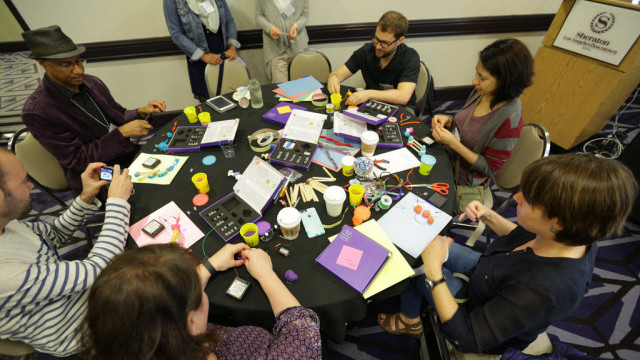The KQED Education team headed to foggy Los Angeles last week for three days of inspired conversations and workshops about using technology to address educational opportunity gaps in today’s digital world. The largest national gathering of scholars and practitioners in the field, DML links theory, policy, research, and practice. We presented an Ignite Talk about the power of video to engage young learners, and presented about the work KQED is doing with other Bay Area organizations to create a hub of connected learning called HIVE Bay Area. We also heard from brilliant folks from around the country about everything from digital badges, to squishy circuits, to remaking payphones as digital storytelling “hotspots”. Here were our biggest takeaways and coolest new ideas from the conference:
- Learning through making: Video production can transform the life of the video producer as much as or more than those who view the video. We heard from young women at the Prerna Girls School in India who used film to express their perspectives about gender equality in their community.
- Need for interconnectedness between in-school and after-school learning: A theme that ran throughout the conference was that digital media and learning is most successful when students can learn and create in a variety of spaces within reach of mentors. Dr. Nichole Pinkard gave an inspiring keynote about the pioneering work in connecting learning through the The Digital Youth Network in Chicago.
- Use Twitter to curate your future learning: New research argues that the more diverse and robust your Twitter network, the more innovative ideas you tend to generate. This is particularly true in the ed tech world, where a robust and growing Twitter community shares and cross-pollinates knowledge.
- Mentors can be found in unexpected places: While the value of mentorship is nothing new, there have been some new research to identify different types of mentors and mapping out their influences in informal ecologies of learning. One particularly interesting example was a study of the informal mentoring that happens in online fan fiction communities.
- Gaming can be a great way to promote empathy: Twine, an open source tool for telling interactive, non-linear stories, is an easy-to-use tool for students to expand their digital storytelling skills with variables, conditional logic, images, CSS, and JavaScript. It publishes directly to HTML, so students can post their work and share it nearly anywhere.
- Let young people lead: Some of the most powerful learning experiences happen when students have a strong stake in program design, and respect for their aesthetic. We attended a workshop about the Yollocalli Arts Reach of the National Museum of Mexican Art in Chicago, where students led a collaboration with working artists to create digital art in their communities.


